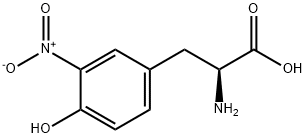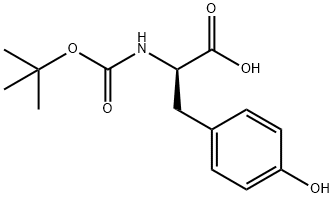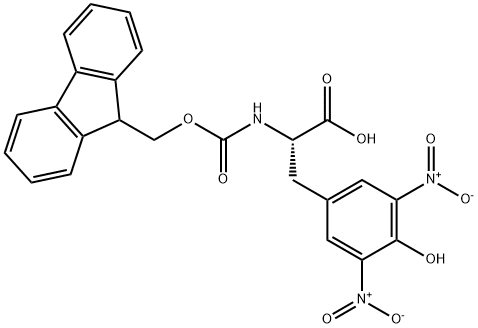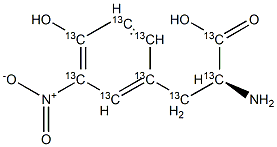3-Nitro-L-tyrosine
- CAS NO.:621-44-3
- Empirical Formula: C9H10N2O5
- Molecular Weight: 226.19
- MDL number: MFCD00007123
- EINECS: 210-688-6
- SAFETY DATA SHEET (SDS)
- Update Date: 2025-11-11 10:47:11

What is 3-Nitro-L-tyrosine?
Description
Nitrotyrosine is formed by peroxynitrite-
Chemical properties
ochre-yellow to yellow-green powder
The Uses of 3-Nitro-L-tyrosine
3-Nitro-L-tyrosine is used as an indicator of the formation of peroxynitrite by NO-dependent oxidative damage.
The Uses of 3-Nitro-L-tyrosine
A marker for peroxynitrite. Oxidant and cytotoxic agent.
What are the applications of Application
3-Nitro-L-tyrosine is an indicator of the formation of peroxynitrite by NO-dependent oxidative damage
Definition
ChEBI: 3-nitro-L-tyrosine is a 3-nitrotyrosine comprising L-tyrosine having a nitro group at the 3-position on the phenyl ring. It is a L-tyrosine derivative, a non-proteinogenic L-alpha-amino acid and a 3-nitrotyrosine. It is an enantiomer of a 3-nitro-D-tyrosine.
Biochem/physiol Actions
Oxidant and cytotoxic agent.
Properties of 3-Nitro-L-tyrosine
| Melting point: | 233-235 °C (dec.) (lit.) |
| Boiling point: | 367.79°C (rough estimate) |
| alpha | 4 º (c=1, 1N HCl) |
| Density | 1.4160 (rough estimate) |
| refractive index | 1.5373 (estimate) |
| storage temp. | Keep in dark place,Inert atmosphere,Room temperature |
| solubility | Aqueous Acid (Slightly), Water |
| pka | 2.17±0.20(Predicted) |
| form | crystalline |
| color | yellow to green |
| Water Solubility | insoluble |
| BRN | 2813157 |
| CAS DataBase Reference | 621-44-3(CAS DataBase Reference) |
Safety information for 3-Nitro-L-tyrosine
| Signal word | Warning |
| Pictogram(s) |
 Exclamation Mark Irritant GHS07 |
| GHS Hazard Statements |
H315:Skin corrosion/irritation H319:Serious eye damage/eye irritation H335:Specific target organ toxicity, single exposure;Respiratory tract irritation |
| Precautionary Statement Codes |
P280:Wear protective gloves/protective clothing/eye protection/face protection. P302+P352:IF ON SKIN: wash with plenty of soap and water. |
Computed Descriptors for 3-Nitro-L-tyrosine
New Products
4,4-Difluoropiperidine hydrochloride tert-butyl 9-methoxy-3-azaspiro[5.5]undecane-3-carboxylate Indole Methyl Resin N-Isopropylurea N,N-Dicyclohexylcarbodiimide(DCC) MELDRUMS ACID 5-METHYLISOXAZOLE-4-CARBOXYLIC ACID Magnessium Bis glycinate Zinc ascorbate 1-bromo-2-butyne 2-acetamidophenol 9(10H)-anthracenone Erythrosin B, 4-Piperidinopiperidine 2-((4-morpholinophenylamino) (methylthio) methylene) malononitrile 2,4-dihydroxybenzaldehyde 3-(4-morpholinophenylamino)-5-amino-1H-pyrazole-4-carbonitrile Methyl 2-methylquinoline-6-carboxylate 2,6-dichloro-4-nitropyridine 4-Bromo-2-chlorobenzonitrile 2-(benzylamino)acetic acid hydrochloride 4-(tert-Butoxycarbonylamino)but- 2-ynoic acid 3,4-dihydro-2H-benzo[b][1,4]dioxepine 1-Phenyl-1-cycloprppanecarboxylicacidRelated products of tetrahydrofuran








You may like
-
 621-44-3 3-Nitro-L-tyrosine 98%View Details
621-44-3 3-Nitro-L-tyrosine 98%View Details
621-44-3 -
 3-Nitro-L-tyrosine CAS 621-44-3View Details
3-Nitro-L-tyrosine CAS 621-44-3View Details
621-44-3 -
 3-Nitro-L-tyrosine CAS 621-44-3View Details
3-Nitro-L-tyrosine CAS 621-44-3View Details
621-44-3 -
 3-(4-amino-1-oxoisoindolin-2-yl)-1-methylpiperidine-2,6-dione 98%View Details
3-(4-amino-1-oxoisoindolin-2-yl)-1-methylpiperidine-2,6-dione 98%View Details -
 20677-73-0 (2,2-diethoxyethyl)methylamine 98%View Details
20677-73-0 (2,2-diethoxyethyl)methylamine 98%View Details
20677-73-0 -
 3-(4-(hydroxyamino)-1-oxoisoindolin-2-yl)piperidine-2,6-dione 98%View Details
3-(4-(hydroxyamino)-1-oxoisoindolin-2-yl)piperidine-2,6-dione 98%View Details -
 57381-49-4 2-bromo-4-chlorobenzonitrile 98%View Details
57381-49-4 2-bromo-4-chlorobenzonitrile 98%View Details
57381-49-4 -
 4,6-dichloropyrimidine-5-carbaldehyde 98%View Details
4,6-dichloropyrimidine-5-carbaldehyde 98%View Details
5305-40-8
